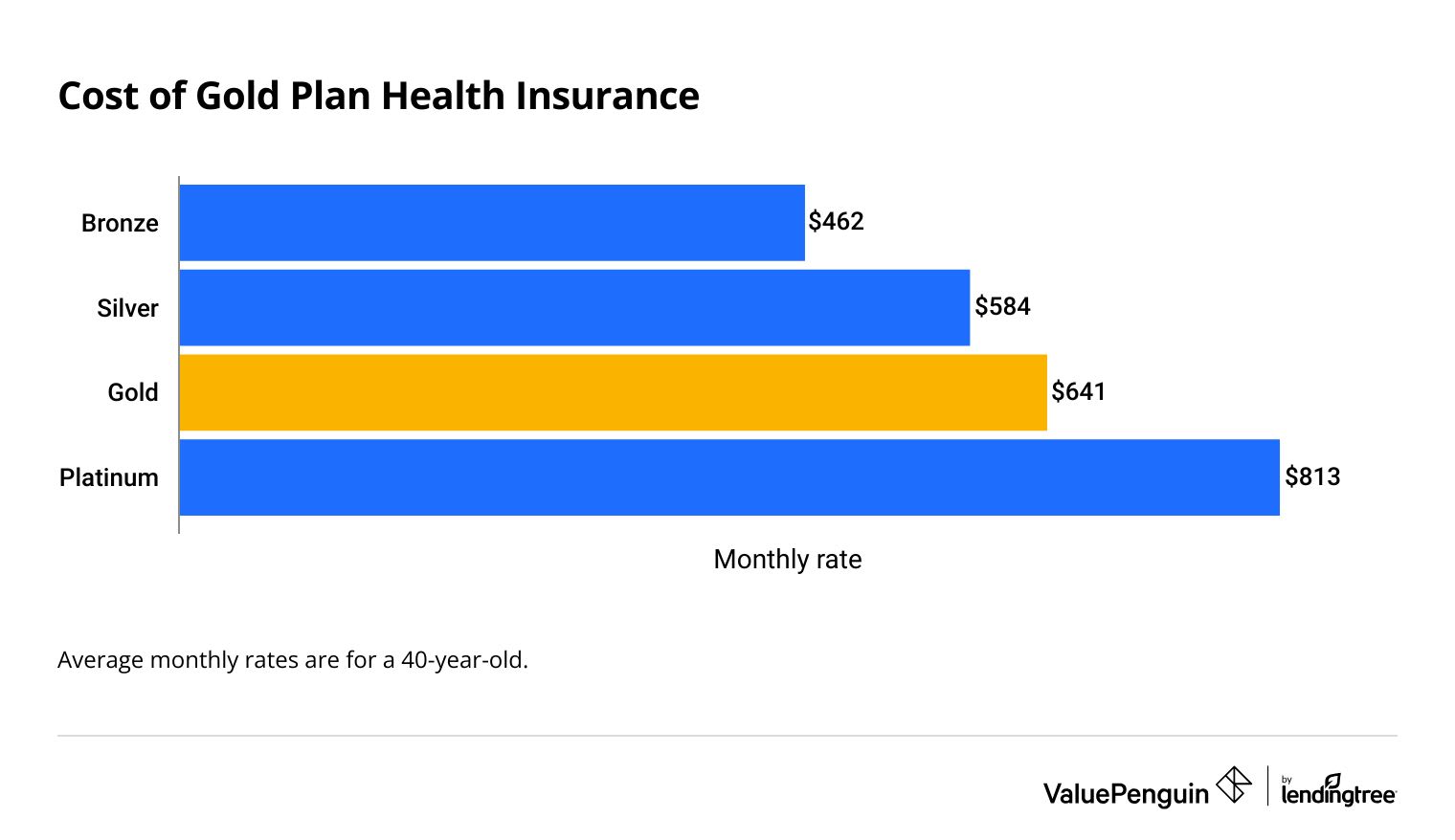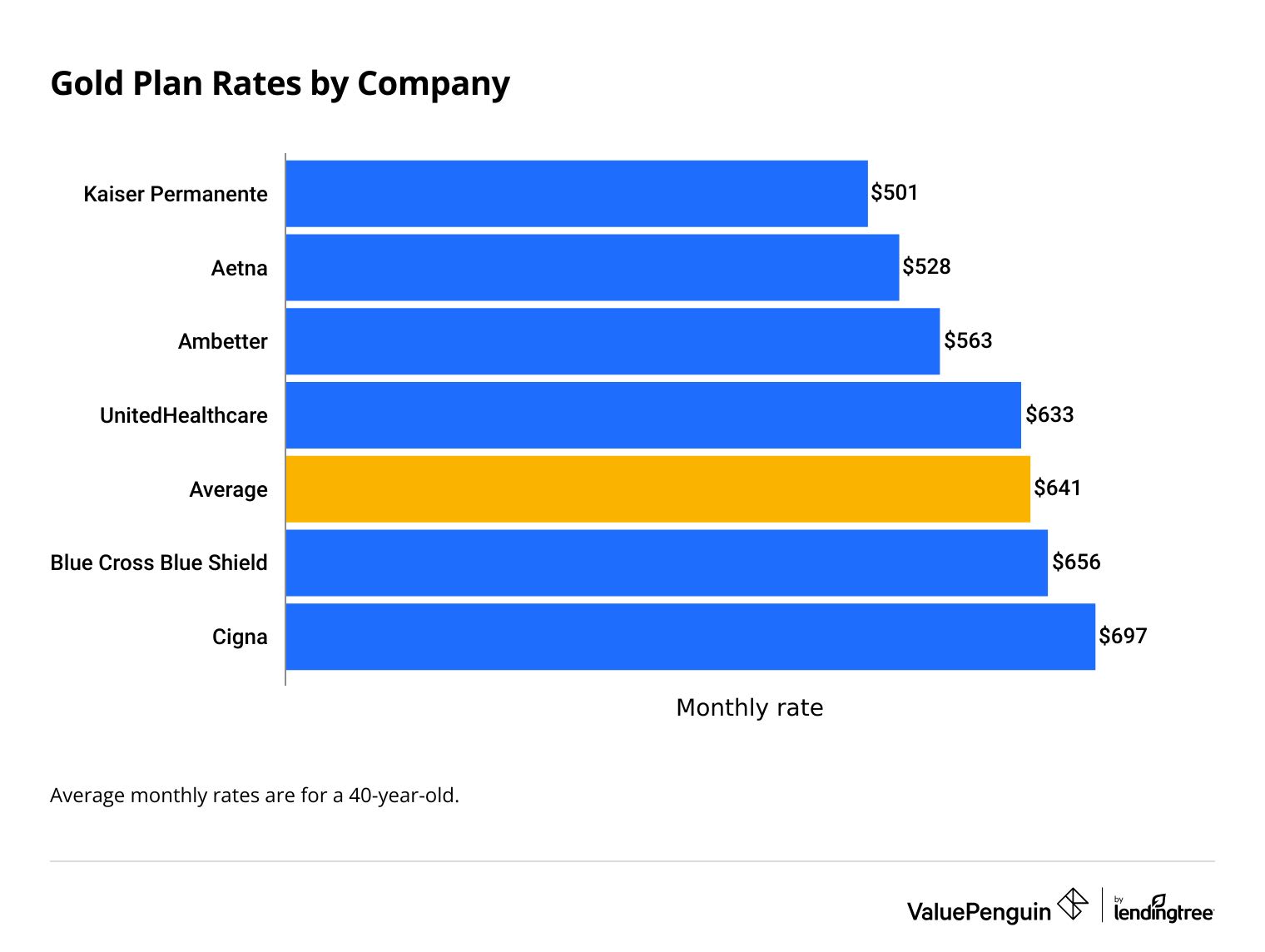Gold Plans: Cost and Coverage
Find Cheap Health Insurance in Your Area
A Gold plan is one of the highest and most expensive levels of health insurance.
Typically, Gold plans pay for about 80% of your medical bills. But better coverage comes with a higher rate: Gold plans cost $641 per month, on average.
Gold plan health insurance
What is a Gold plan?
A Gold plan is a higher level of health insurance that pays for more of your medical costs.
Because it offers more coverage than other plan tiers, it has a higher monthly rate.
Usually, Gold is the highest level of coverage you can buy. Only platinum health insurance covers more of your medical bills, but it's only available in 16 states and Washington, D.C. Gold plans are available nationwide.
Is a Gold plan right for you?
A Gold plan might be the best option if you need medical care often, have a complex medical condition or need expensive medical treatment. Gold plans cost more than some other levels of coverage, but the higher cost might be worth it if your medical bills are expensive.
But if you have a low income, a Gold plan might not be the best option, even if your medical bills are high. A Silver plan might be better if you make less than $36,450 per year. You could qualify for lower deductibles, coinsurance and copays through cost-sharing reductions, which are only available on Silver plans. If you qualify, a cheaper Silver plan could give you coverage that is similar to a Gold plan.
How much does a Gold plan cost?
Gold plans cost $641 per month, on average.
They cost more than a Silver or Bronze plan because they pay for more of the bill when you go to the hospital or doctor. But most people don't pay full price for their Gold health insurance. If you make between $14,580 and $58,320 per year, you can get a lower rate with a subsidy.

Find Cheap Health Insurance in Your Area
Average cost of health insurance by plan tier
Plan tier | Monthly rate |
|---|---|
| Bronze | $462 |
| Silver | $584 |
| Gold | $641 |
| Platinum | $813 |
Average monthly rate for a 40-year-old.
Gold plan rates by company
Because so many health insurance companies sell Gold plans, you often can find a cheaper plan by shopping around.
For example, Kaiser Permanente's Gold plans are $140 cheaper each month compared to the national average. But Gold plans from Cigna cost $56 more each month.

Gold plan rates
Company | Monthly rate | |
|---|---|---|
| Kaiser Permanente | $501 | |
| Aetna | $528 | |
| Ambetter | $563 | |
| UnitedHealthcare | $633 | |
| Blue Cross Blue Shield | $656 |
Average monthly rate for a 40-year-old with a Gold plan.
Gold plan rates by state
The cost of a Gold plan changes based on where you live. The cheapest state to buy a Gold plan is Maryland, where the average cost is $384 per month. But in New York state, you'll pay $1,067 per month, on average.
State | Gold plan rate |
|---|---|
| Alabama | $727 |
| Alaska | $842 |
| Arizona | $652 |
| Arkansas | $557 |
| California | $711 |
Average monthly rate for a 40-year-old with a Gold plan.
Find Cheap Health Insurance in Your Area
What does a Gold plan cover?
Gold plans have to include coverage for at least 10 types of medical care.
These are called the "essential health benefits." All health insurance plans that you buy on HealthCare.gov or a state health insurance marketplace cover these situations.
- Doctor visits
- Preventive, wellness and chronic illness care
- Prescription medicines
- Lab services
- Emergency care
- Hospital care
- Pregnancy, maternity and newborn services
- Pediatric services
- Mental health and substance use care
- Rehabilitation care
Your plan might have coverage for more types of medical care, but it will at least have coverage for these 10 situations. Some Gold plans have dental and vision coverage for adults. Gold health insurance, like most other health insurance, doesn't usually cover cosmetic surgeries or treatments, vaccines you have to get before traveling or anything else that is considered not medically necessary.
The biggest perk of a Gold plan is that it pays for about 80% of your medical bills.
That means that, on average, you only have to pay for 20% of your medical bills. A Bronze plan, in contrast, usually only pays for about 60% of your medical bills, leaving you with the remaining 40%.
Example: Doctor visit
Imagine you hurt your ankle while on a walk. You go to your doctor, who examines it and takes an X-ray to make sure it isn't broken. The doctor visit costs $100 and the X-ray costs $200. Both are covered, but the amount you have to pay depends on the plan you have.
- Total cost of the visit: $300
- Plan pays 80%: $240
- You pay 20%: $60
- Total cost of the visit: $300
- Plan pays 60%: $180
- You pay 40%: $120
Every plan is unique and has its own deductibles, copays and coinsurance. If you go to the doctor often or need expensive medical treatments, a Gold plan could save you money even though it costs more each month. But you may have to pay more or less than the 20% figure. It all depends on the specific structure of your plan.
Frequently asked questions
What is a Gold plan?
A Gold plan is a level of health insurance that usually pays for about 80% of your medical bills. You have to pay the other 20% yourself through your deductible, coinsurance and copays.
Is a Gold health plan worth it?
A Gold plan might be worth it if you need a lot of medical care. For example, if you know you need a surgery within the next year or if you manage a chronic condition, choosing a Gold plan could help you lower your medical bills. But if you have a low income, you might want to choose a Silver plan. You could qualify for lower deductibles, copays and coinsurance amounts that give you coverage as good as a Gold plan for a cheaper rate.
What is the difference between a Gold plan and a Silver plan?
A Gold plan pays for more of your medical costs than a Silver plan but usually costs more. On average, a Gold plan pays about 80% of your bills, while a Silver plan pays around 70%. That means, with a Silver plan, you have to pay a larger share of your medical bills than you would with a Gold plan.
Methodology and sources
Average costs for Gold plans and other plan tiers are from the Centers for Medicare & Medicaid Services (CMS). ValuePenguin used the CMS public use files (PUFs) to calculate average costs by plan tier, company and state. Costs are averages for a 40-year-old. Plans and providers for which county-level data was included in the CMS Crosswalk file were used in our analysis; those excluded from this data set may not appear.
Other sources include HealthCare.gov.
Editorial note: The content of this article is based on the author's opinions and recommendations alone. It has not been previewed, commissioned or otherwise endorsed by any of our network partners.





